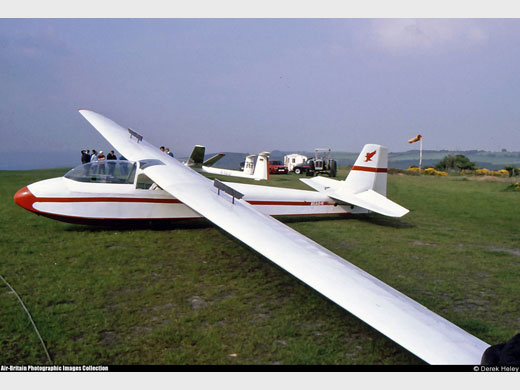
Slingsby T-42 Eagle
| DONNÉES GÉNÉRALES |
| Année du premier vol (ou de design, si seul projet) |
1954 |
| Pays | Angleterre |
| Designer(s) | Slingsby Sailplanes Ltd |
| Premier constructeur | Slingsby |
| Type d'appareil | Planeur |
| Fonction | Initiation |
| SPÉCIFICATIONS TECHNIQUES |
| Envergure | 17.65 m |
| Longueur | 8.35 m |
| Hauteur | 1.83 m |
| Allongement | 14.8 |
| Surface alaire | 21.3 m2 |
| Profil aile | NACA 63-3-618 (emplanture) – NACA 4412 (saumon) |
| Masse à vide | 318 kg |
| Masse maxi | 522 kg |
| Charge alaire | -- |
| Vitesse mini | -- |
| Vitesse maxi | -- |
| Finesse maxi | 31 à 77 km/h |
| Taux de chute mini | 0.61 m/s à 77 km/h |
| Nb sièges | 2 |
| Structure | Bois et toile |
AUTRES INFORMATIONS
| Constructeur(s) |
| ||||||
| Infos techniques | Type 42 Eagle 1 - Prototype, premier vol le 12 juin 1954; 17.86-metre span Type 42A Eagle 2 - Deuxième prototype, avec des aérofreins déplacés, premier vol en mai 1956 Type 42B Eagle 3 - version de production, envergure 17,72 m et cockpit avancé. Type 55 Eagle 4 (Regal) - envergure portée à 20m - un appareil converti en 1966 Aile cantilever en 3 parties, partie centrale de 6,1 m. Aérofreins. | ||||||
| Histoire résumée | Le premier prototype Mk. 1 a volé le 12 juin 1954. Il était dessiné dans le but de satisfaire à la demande de l'A.C.T. d'un biplace d'entraînement à la performance. Un second pototype, T-42A a volé en mai 1956. Il avait une partie centrale d'aile réduite à 4,22 m (les aérofreins étant placées dans les panneaux d'ailes extérieurs) et le bord d'attaque de l'aile échancré pour laisser place au cockpit. Cette machine a gagné le championnat du monde 1956 à Saint-Yan (France) en catégorie biplace aux mains de H.C.N. Goodhart et F. Foster. The intention was to design and build an advanced 2 seater that could be used for cross country instruction. The prototype, which had a span of 58 feet 5 inches, was constructed very much in the same fashion as the Skylark 2, and first flew on the 12th June 1954. It was entered in the 1954 world championships at Camphill and flown by Lorne and Anne Welch. The result was disappointing, 7th out of 9. This led to Fred Slingsby making changes to the wing design which resulted in the second prototype being referred to as the T42A (Eagle 2)– first flown May 1956. It was the T42A that was flown by Nick Goodhart and Frank Foster in the two seater class at the 1956 world championships held at St Yan, France. To everybody’s surprise the Eagle won, and won what’s more by a considerable margin. This led to the aircraft being put into production in 1957, the T42B (Eagle 3) had additional minor changes, for example a lengthened nose. One T42B was further modified in 1966 to have a 20 metre (65 feet 6 inches) span wing and is referred to as the Type 55 (Eagle 4) “Regal Eagle”. | ||||||
| Liens personnalités | Pas de personnalité associée. | ||||||
| Compléments docs |
SOURCES DOCUMENTAIRES
| Liens WEB | Site : Flight Global . Vue éclatée. (2010-05-15 CL) Site : Wikipedia . Histoire + une photo + specs. (2010-05-15 CL) Site : R. Cawsey . Appareils immatriculés. (2010-05-15 CL) Site : Gliding Heritage Centre . Guide de référence des productions Slingsby. (2014-05-12 CL) Site : Richard Cawsey . Liste des T-42 Eagle. (2014-10-21 CL) Site : Hangar Flying . Première traversée de la Manche par un biplace, par Bob Werhegghen (14 mai 2021). (2021-05-19 CL) |
| Livres | British Gliders and Sailplanes 1922-1970 par ELLISON, Norman (1971) [p. 51, 202, 209, 264. Note + plan 3 vues + specs]. Sailplanes 1945-1965 par SIMONS, Martin (2001) [p. 159. Note + plan 3 vues + specs]. Slingsby Sailplanes par SIMONS, Martin (1996) [p. 179-183. ]. |

Team J2mcL © 2003 -
- Pages optimisées pour Mozilla Firefox

